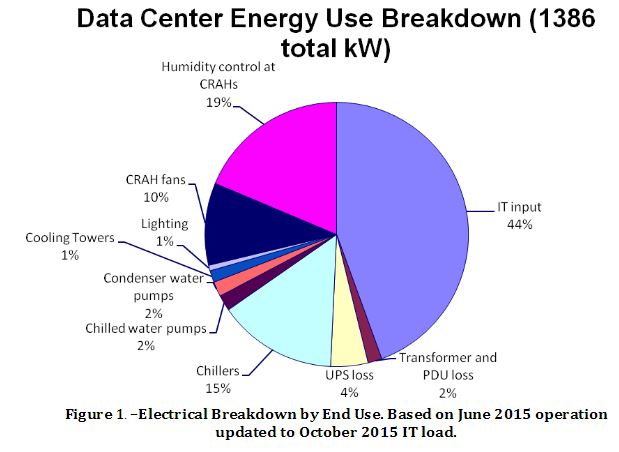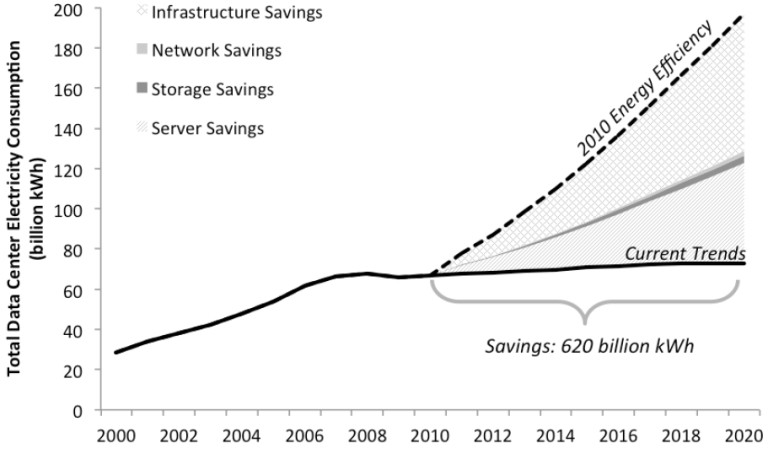Data centers are among the most important and energy-intensive facilities for the U.S. and global economy. Data centers process billions of pieces of information daily to power our work and social lives. That volume of processing power requires multiple large facilities filled with rows of servers that run continuously, which consumes an enormous amount of energy that has a direct impact on a data center’s bottom line. This article will examine data center energy efficiency, how data centers consume energy, and air management and HVAC energy efficiency strategies to reduce costs.
Data Center Energy Use
Pacific Gas and Electric Company (PG&E) estimates data centers can consume “100 to 200 times as much electricity as standard office spaces.” Furthermore, a recent study conducted by the U.S. Department of Energy (DOE) in collaboration with the Lawrence Berkeley National Laboratory (NBNL) concluded data centers consumed 70 billion kilowatt hours of electricity in 2014, representing two percent of total U.S. energy consumption. Significant data center energy efficiency advancements, however, have helped mitigate rising energy consumption. From 2005 to 2010, data center energy consumption rose 24 percent, but between 2010 to 2014, it increased only 4 percent. Between 2015 and 2020, the DOE estimates only another 4 percent increase.
According to a 2015 NBNL study, IT input is, by far, the leading cause of energy use in data centers. Humidity control, chillers, and fans are the next largest energy consumers, and are a direct result of excessive heat and humidity generated by IT input. Continuous data processing in an enclosed room full of servers produces high amounts of heat and humidity. Optimizing cooling cycles and humidity levels while maximizing energy efficiency remains a challenge for data center facility managers.
The following graph by the NBNL details the breakdown of energy use of a typical data center.

Source: Lawrence Berkeley National Laboratory
Data Center Energy Efficiency
According to a 2014 National Resource Defense Council (NRDC) report, there are 3 million data centers in the U.S., but only 5 percent of those are maximizing energy efficiency. Thus, the majority of data centers are ripe for energy efficient improvements. According to the DOE, cost savings up to 40 percent can be achieved. Energy efficiency is also paramount to curb the ongoing issue with energy consumption growth, which has been an amplifying concern in recent years. A study conducted in collaboration with the DOE, Standford University, Northwestern University, and Carnegie Mellon University estimates 620 billion in energy savings between 2010 and 2014 were due to energy efficiency advancements.
The graph below depicts total data center electricity consumption from 2000 to 2020.

Source: Data Center Knowledge
Data center energy efficiency mainly focuses on tackling the main driver of energy consumption: IT input, which has a direct relationship with heat and humidity management. Heat and humidity have proven to be a detriment to data center performance, with additional risk of equipment failure. As a result, most data center energy efficiency investments center around air management and HVAC system improvements, including air-side and water-side economizers and variable frequency drives on air handling units.
Air-side Economizers
Air-side economizers are a key component to air management. Instead of reconditioning and recirculating hot exhaust air, air-side economizers collect outside air for conditioning and distribution while removing hot exhaust air from the space immediately. By allowing the system to avoid mixing hot exhaust air with conditioned air, cost savings of up to 60 percent are possible on this specific measure. This is especially beneficial at night, when outside air temperatures drop.
Water-side Economizers
Water-side economizers are beneficial for data centers that utilize water- or air-chilled water plants. Water-side economizers can produce chilled water from the evaporative capacity of the cooling tower, displacing the chiller during the winter. Cost savings of up to 70 percent are possible during the winter on this specific measure.
Air Handling Unit
The air handling unit (AHU) is a component of the HVAC system and is responsible for regulating and circulating the air. Typical AHUs have significant reserve capacity, which can be leveraged to improve efficiency when combined with variable frequency drives to optimize variable air volume (VAV) fan speeds.
Leveraging Economies of Scale
A new study developed by Emerson Network Power and Ponemon Institute has proven that energy efficiency combined with economies of scale are an effective strategy to reducing costs. According to Facility Executive, the study shows that costs decrease as data center size increases, with energy costs experiencing the largest decrease—upwards of 64 percent—followed by operating costs. Douglas Adams of RagingWire Data Centers notes:
“The important thing is that whether you are a cloud provider or a colocation provider – scale matters. At scale providers get economies in production and efficiencies in operation that they can pass along to their customers and win in the marketplace.”
Leading tech firms, such as Microsoft, Amazon, and Google, take economies of scale to the next level, spending billions on data center improvements, including the construction of hyperscale facilities: “enormous facilities designed for maximum efficiency from the ground up.” Facebook even built a 290,000 square-foot facility at the edge of the Arctic Circle to capitalize on the area’s natural frigid environment.
Bottom Line
A focus on data center energy efficiency has come a long way in recent years, but the majority of U.S. data centers are still inefficient. Thus, data centers are exemplary for energy efficiency improvements. Improving data center energy efficiency is necessary to improve data center performance and cut costs. By conducting air management and HVAC system improvements and leveraging economies of scale, data centers will augment their bottom line.




